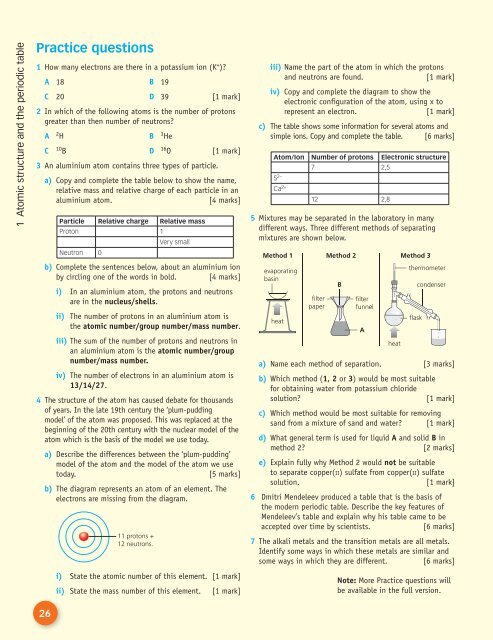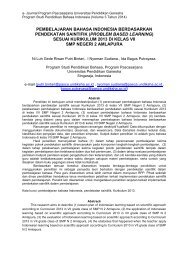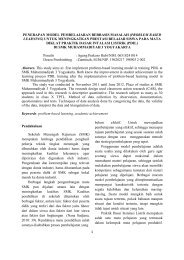Create successful ePaper yourself
Turn your PDF publications into a flip-book with our unique Google optimized e-Paper software.
1 Atomic structure and the periodic table<br />
Practice questions<br />
1 How many electrons are there in a potassium ion (K + )?<br />
A 18<br />
C 20<br />
B 19<br />
D 39<br />
[1 mark]<br />
2 In which of the following atoms is the number of protons<br />
greater than then number of neutrons?<br />
A 2 H<br />
C 10 B<br />
B 3 He<br />
D 16 O<br />
[1 mark]<br />
3 An aluminium atom contains three types of particle.<br />
a) Copy and complete the table below to show the name,<br />
relative mass and relative charge of each particle in an<br />
aluminium atom.<br />
[4 marks]<br />
Particle Relative charge Relative mass<br />
Proton 1<br />
Very small<br />
Neutron 0<br />
b) Complete the sentences below, about an aluminium ion<br />
by circling one of the words in bold. [4 marks]<br />
i) In an aluminium atom, the protons and neutrons<br />
are in the nucleus/shells.<br />
ii) The number of protons in an aluminium atom is<br />
the atomic number/group number/mass number.<br />
iii) The sum of the number of protons and neutrons in<br />
an aluminium atom is the atomic number/group<br />
number/mass number.<br />
iv) The number of electrons in an aluminium atom is<br />
13/14/27.<br />
4 The structure of the atom has caused debate for thousands<br />
of years. In the late 19th century the ‘plum-pudding<br />
model’ of the atom was proposed. This was replaced at the<br />
beginning of the 20th century with the nuclear model of the<br />
atom which is the basis of the model we use today.<br />
a) Describe the differences between the ‘plum-pudding’<br />
model of the atom and the model of the atom we use<br />
today.<br />
[5 marks]<br />
b) The diagram represents an atom of an element. The<br />
electrons are missing from the diagram.<br />
11 protons +<br />
12 neutrons.<br />
i) State the atomic number of this element. [1 mark]<br />
ii) State the mass number of this element. [1 mark]<br />
iii) Name the part of the atom in which the protons<br />
and neutrons are found.<br />
[1 mark]<br />
iv) Copy and complete the diagram to show the<br />
electronic configuration of the atom, using x to<br />
represent an electron.<br />
[1 mark]<br />
c) The table shows some information for several atoms and<br />
simple ions. Copy and complete the table. [6 marks]<br />
Atom/Ion Number of protons Electronic structure<br />
7 2,5<br />
S 2−<br />
Ca 2+ 12 2,8<br />
5 Mixtures may be separated in the laboratory in many<br />
different ways. Three different methods of separating<br />
mixtures are shown below.<br />
Method 1<br />
evaporating<br />
basin<br />
heat<br />
filter<br />
paper<br />
Method 2<br />
B<br />
filter<br />
funnel<br />
A<br />
heat<br />
Method 3<br />
thermometer<br />
flask<br />
condenser<br />
a) Name each method of separation. [3 marks]<br />
b) Which method (1, 2 or 3) would be most suitable<br />
for obtaining water from potassium chloride<br />
solution?<br />
[1 mark]<br />
c) Which method would be most suitable for removing<br />
sand from a mixture of sand and water? [1 mark]<br />
d) What general term is used for liquid A and solid B in<br />
method 2?<br />
[2 marks]<br />
e) Explain fully why Method 2 would not be suitable<br />
to separate copper(II) sulfate from copper(II) sulfate<br />
solution.<br />
[1 mark]<br />
6 Dmitri Mendeleev produced a table that is the basis of<br />
the modern periodic table. Describe the key features of<br />
Mendeleev’s table and explain why his table came to be<br />
accepted over time by scientists.<br />
[6 marks]<br />
7 The alkali metals and the transition metals are all metals.<br />
Identify some ways in which these metals are similar and<br />
some ways in which they are different. [6 marks]<br />
Note: More Practice questions will<br />
be available in the full version.<br />
26





